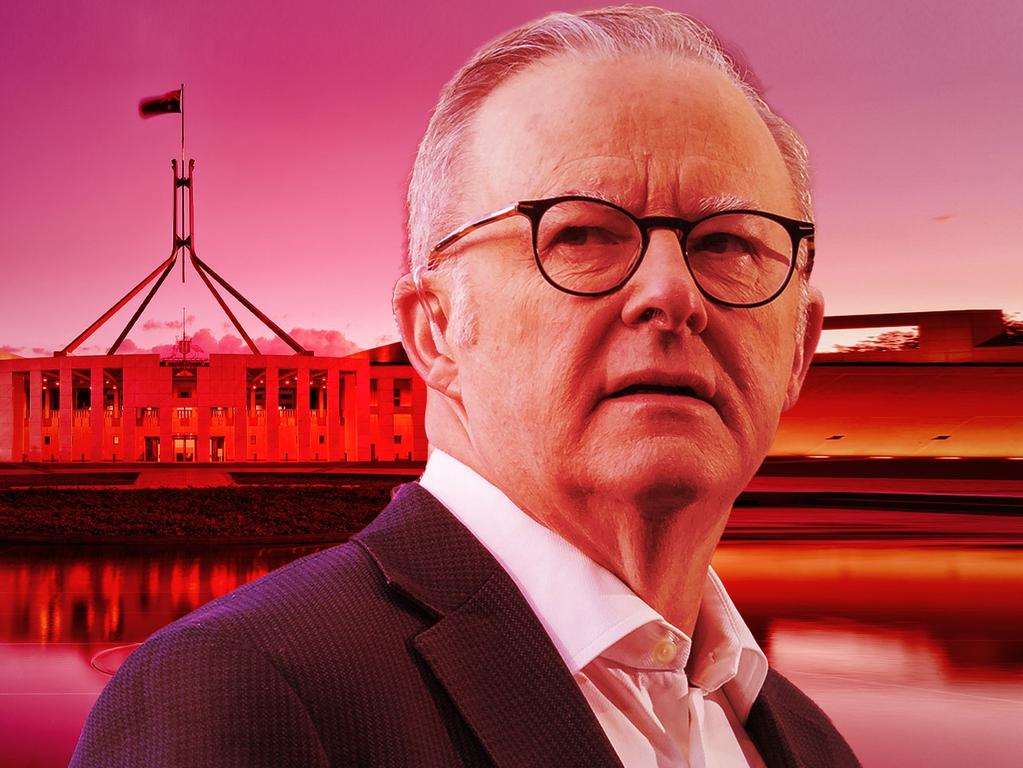It’s time to refresh our pragmatic patriotism
Anthony Albanese may enjoy historic electoral abundance, but as Labor begins a second term, Australia confronts economic scarcity.

Labor’s victory lap in the aftermath of the May 3 boilover rolls on. In the long build-up to the return of parliament in late July, there has been the immolation spectacle of the vanquished and a week’s worth of news every hour beyond our shores.
On the government side, there have been contributions from the backroom, including from the campaign maestro, the outgoing Treasury secretary and an assistant minister. They’ve all been a warm-up for progressive patriot Anthony Albanese, who returned to the insiders’ circuit this week with an appearance at the National Press Club in Canberra to outline his second-term plans.
The Prime Minister’s 30-minute set pieces invariably lay down a lot of content: piles of bureaucratic carbs, slices of policy protein, mixed in with spices from the narrative queens. No winning flourishes held back, no talking points left behind.
In any case, the parts of the address that caught the ear were when Albanese spoke about securing “a mandate to act” as well as the “how” of delivering lasting change in the Australian way.
Albanese was expansive. Beyond global uncertainty and economic instability, democracy was under siege. “It is the more corrosive proposition that politics and government and democratic institutions, including a free media, are incapable of meeting the demands of this moment,” he said. While some dismiss such sentiment, and “others cynically seek to harvest it”, he declared “our responsibility is to disprove it”. How? By aiming high and building big.
“The commitments the Australian people voted for in May are the foundation of our mandate, they are not the limits of our responsibilities or our vision,” Albanese said. If he goes beyond the promises of the campaign, say on tax, deregulation or defence, as many now hope, it will be through policies that “Australians own and understand”.
“Reform that clearly serves a national purpose and the national interest,” he said. “Change that empowers and engages people, with a sense of choice and agency. Change that generates its own momentum and builds its own staying power. That’s the long-term, lasting change our government wants to deliver.” Hand on heart, he said “change imposed unilaterally by government rarely endures”. That probably counts as giving false hope to the activists responsible for the nuclear strike on Labor’s move to double the tax rate on earnings of superannuation balances above $3m.
There were competing flavours in this chunky rhetorical soup. For instance, will the government be stepping back, to let the private sector drive growth, or stepping up to correct market failures? Is Labor about growing the pie or carving it up? Depends. Consistency may be for small minds. Albo is writing his version of how to be both.
With the ballast of 94 seats in the lower house and a Senate that conceivably offers two paths to success on legislation, Labor’s operating mode this term will not look much different to its first. But the agenda will, because of circumstances, change.
In Labor’s first three years, the state was your mate. Albanese customarily rattles off a laundry list of promises delivered and several more to come, such as student debt relief and universal childcare.
His incoming departmental chief, Steven Kennedy, describes it as investing in the “social compact”. The pandemic’s long tail of paternalism, income protection and bill relief, growth of the care economy (including wage boosts for its poorly paid workers) and energy market interventions eased the pain of elevated living costs for families, much of it caused by the Reserve Bank’s assault on decades high inflation. Yet here we are with the “soft landing” officials were aiming for, with low unemployment and consumer inflation in the central bank’s target band, and achieved by an experimental approach of “rates not as high as elsewhere but for longer”.
But the fiscal costs endure, with Canberra and (especially) the provinces pushing their spending powers and tolerance of credit watchers to the max. It’s undeniable that, as RBA head of domestic markets David Jacobs pointed out in a speech in Tokyo on Thursday, there has been an “extraordinary decline” in what Australians owe to foreigners in recent years (or our net foreign liabilities) because Australians have accumulated foreign assets, mainly equity.
No doubt as the Prime Minister rubs shoulders with G7 leaders in Canada he’ll have his chest out as a lo-fi debtor. Australia’s general government net debt at around 30 per cent of GDP is among the lowest in the developed world; the US and Britain are edging towards 100 per cent, France, Italy and Japan are all in three figures, while Canada is at 12 per cent (as it includes the assets of two government pension funds). But let’s get real. We don’t run a reserve currency, we’re a mid-sized trading nation hugely dependent on commodity earnings, an importer of capital.
Canberra’s structural budget balance (that is, the underlying cash balance stripped of cyclical factors) still will be in deficit in 2033. When you take into account spending on “off budget” items designated as investments (such as Snowy 2.0 and the NBN), the cumulative deficit across five years is $104bn higher.
Treasury projects that spending on big-ticket areas, including debt interest, the NDIS, defence, hospitals, medical benefits, aged care and the childcare subsidy will grow faster than the dollar value of GDP over the next decade. As Kennedy said in a speech in May: “The need for additional insurance against global risks will necessarily require careful prioritisation, and maybe reprioritisation, of areas of expenditure that are growing.”
Not only will the budget need flexibility in case of shocks but there will be pressure to significantly raise defence spending. We’ve already seen Japan, Canada, Britain and New Zealand committing to increase their military investments. Local hawks have backed US Defence Secretary Pete Hegseth’s call to raise our spending from 2 per cent to 3.5 per cent of GDP.
Albanese has consistently pushed back, arguing defence should be governed by one factor: the capability we need to keep us safe. “Arbitrary figures lead to a cul-de-sac,” he said in response to a reporter’s question about US-mandated targets.
Labor’s post-election pivot to build resilience for a dangerous and fragmented world involves raising the productive capacity of the economy through reforms.
The only surprise in Albanese’s NPC address was to announce a roundtable on a growth and productivity to be convened by Jim Chalmers in August.

Inquirer is routinely asked for a list of a half-dozen things that would cure the productivity malaise. But even three dozen quick reforms may not move the needle; it’s a long game, point by point, and difficult to score. My colleagues at the nonpartisan and not-for-profit e61 Institute, Michael Brennan and Ewan Rankin, put it well as they warned of the trap of the “miracle pill” approach. “Productivity policy is like diet and exercise – daily, broadbased fundamentals that show incremental benefits across time,” they argued in our pages this week.
The policy dialogue in Parliament House no doubt will be based on the interim findings of the Productivity Commission’s reviews of the five pillars of prosperity, including a more dynamic and resilient economy; building a skilled and adaptable workforce; harnessing data and digital technology; delivering quality care more efficiently; and investing in cheaper, clean energy and the net-zero transformation.
The business lobbies, burned by jobs and skills summitry in 2022, have welcomed the initiative, while the Coalition’s walking wounded – the folks who promised taxpayer-funded nukes, supermarket divestment and tax deductibility of mortgage costs – are calling it a stunt.
Of course, it may turn out that way. But given productivity is front and centre, former PC chair Brennan and Rankin urged all participants to stay clear-eyed and honest: “Productivity policy operates across the broad sweep of government involvement in the economy, in fiscal programs, regulation and government service delivery. If these are set to maximise efficiency, encourage innovation and allow new business models, then we stack the odds in our favour. If governments pursue populist or ideological departures, it is no good seeking out a quick fix.”
At the end of the question and answer session on Tuesday, Albanese was asked whether he had read Abundance by US journalists Ezra Klein and Derek Thompson, which is doing the rounds of Labor’s economics team and has tremendous buzz in progressive-think land. “No,” he replied, then went on to emphasise that there was a big difference between US and our national interests and political play. Someone in the ministry should add Albo to the wonks’ chat group!
The Wall Street Journal’s Molly Ball dissected the book’s arguments and the “raging political fad” it has ignited.
Amid the Democrats’ post-poll angst, Ball finds a gathering of politicians, activists and the rank-and-file around an unlikely message: The government is broken. “The policy tome argues that Democrats must grapple with – and shoulder some blame for – the fact that blue states like California are mired in high-price stagnation, while red states such as Texas and Florida offer a dynamism and quality of life that keep attracting new residents,” Ball wrote this month.

“Regulations intended to protect consumers, communities and the environment, they say, have metastasised to create an administrative regime that prevents anything from getting built, from high-speed rail projects to housing.”
In Melbourne last week, Labor’s walking-talking nonstop ideas factory Andrew Leigh spoke about the abundance agenda for Australia. The Assistant Minister for Productivity, Competition, Charities and Treasury used housing as an example: it’s the scarcity we built because we’ve designed a system of approvals, regulations and construction where it is now simply too difficult to deliver new homes.

There are similar challenges in infrastructure and clean energy, even in cashing in on world-leading university research. “We’re not short on ideas,” Leigh told the Chifley Research Centre. “We’re not short on demand. We’re not even short on capital. What we’re short on is the capacity to deliver at the pace and scale that the moment demands.”
The former economics professor says we must refresh our institutions so they are trusted to act, “not just to review, approve and regulate but to enable … abundance isn’t about extravagance, it’s about capability. About having systems that match our aspirations.”
Labor has an abundance of political capital amid economic scarcity. In the March quarter, GDP per person fell to the lowest level since September 2021. While productivity may not get hearts racing in party focus groups, as ALP national secretary Paul Erickson said recently, voters feel something is missing in our politics and its practitioners; they yearn for a plan and serious policy contests they can have a stake in.
Research shows Australians are, in the abstract at least, up for tax and productivity reform. A survey on Labor’s second term agenda by JWS Research found 61 per cent of respondents support the Treasurer’s higher focus on productivity, with around three-quarters of men aged over 65 and ALP voters in support.
What came first, the reform chicken or policy egghead? Doesn’t matter: our living standards have just been through the weakest growth period in six decades and it’s clear there’s a lot of work to do to get more from our precious capital and labour.
There is no believing we can muddle through and something will turn up to set things right; that mix of wilful delusion and serial exceptionalism won’t cut it in this new world of scarcity, instability and peril. We need to get back to the conventional economic and social models that have served us well: co-operation, contestable and evidence-based policy, free markets, targeted safety nets, sustainable budgets, workplace flexibility and the fair go. Call it pragmatic patriotism.






